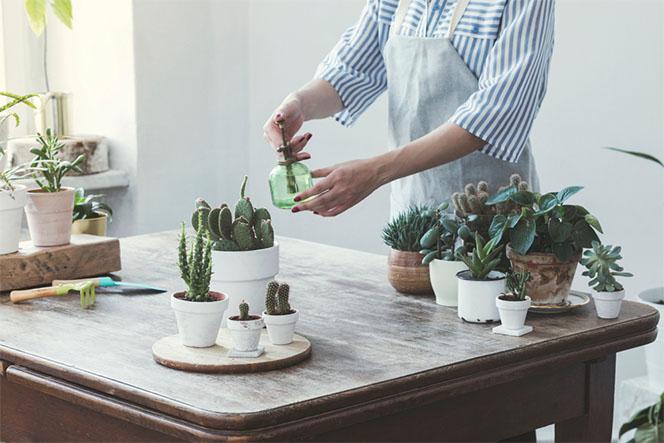Make sure to use a pot with drainage hole
If you’re a beginner, we highly recommend using pots with drainage holes. Though it is possible to grow succulents in pots without drainage holes, the risk of rot is much higher as water may sit at the bottom of the pot and keep the soil wet for an extended amount of time. It also takes more effort and expertise as you have to carefully monitor the watering schedule and the amount of water needed to keep the succulents in their best shape and health. Luckily, you can add drainage holes to most containers with a diamond tip drill bit. For glass containers, you can add a layer of pebble and charcoal to encourage good drainage.
Terracotta pot with drainage hole | Click here to purchase
The material of the pots is also important in keeping your succulents happy. Pots made of porous materials such as terracotta and ceramic allow water to evaporate faster than plastic or glass pots. Make sure you know the pros and cons of different pot materials before choosing one for your plants.
Use fast draining soil
Succulents rot easily if they sit in water for too long. It is extremely important to provide fast draining soil that doesn’t retain water to allow the roots to breathe. Using fast draining soil + pot with drainage holes allows you to be more carefree when watering your succulents. Fast draining soil designed specifically for succulents and cacti can be easily found in local garden centers or home improvement stores at an affordable price. You can also create your own soil mix by simply mixing light, porous potting soil + fluffy materials such as perlite or pumice.

Always check the soil before watering
Some succulent species need more water than others. Most will have wrinkles and dropping leaves when they need more water. But you should not water your succulents too often. Generally, simply check the top of the soil, if it’s completely dry, it’s time to water. Make sure to thoroughly soak the soil and then give it some time to dry out. Don't water it again until the soil becomes completely dry.
It’s always better to underwater than overwater. Therefore, for beginners, we recommend that you water once every 2 weeks at first, then observe your succulents’ reactions and adjust the watering schedule accordingly. Learning to tell if your succulents are overwatered or underwatered might seem daunting but it can be done.
What type of water should you use
For most plants and succulents, the best type of water to use is rain water or distilled water. Tap water often contain lots of mineral like magnesium or calcium that can build up in the soil or appear on the leaves as white dot. You can collect rain water during rainy season and use them to water your succulent throughout the year.

Water at the roots. Don’t spray or water on the leaves
Watering bottle | Click here to purchase

- Don’t use spray bottles. A common watering mistake is that you can water your succulents by simply spraying water on their leaves. In fact, that only works for propagating leaves and baby plants. In adult plants, it’s the root that absorbs water and nutrition. Use watering bottles or cans that have a long small spout to water gently and directly at the root ball. Watering bottles are lightweight and have scale marks that allow you to control the amount of water you want to give your plants.
- Don’t water on the leaves or on top of the plant. Water that stays on the leaves for too long can cause the leaves to rot.
- Don’t water when it’s humid/raining or extremely hot.
- Don’t water at noon or in the afternoon. The best time to water is in the morning.
- Use rainwater, distilled water, or filtered water if possible to avoid mineral deposit. If you use tap water, leave it out overnight to allow some of the treated chemicals to dissipate into the air.
Don't hesitate to comment below if you have any questions for us on watering techniques. We would also love to learn effective ways you use to keep your succulents happy and healthy.
SEE MORE ABOUT HOW TO SAVE UNDERWATERED SUCCULENTS
For Types of Succulents Careguide. Read more information here.
If you found this article interesting, share it with your succulent loving friends!
And get a free plant when your friends make an order. Sign up here!
Learn more about how to nurture and enjoy many gorgeous succulents and clever decoration tips with our newsletter. Let's sign up!

































